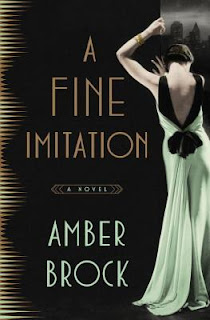Rating: ★ ★ ★ ★ ★
Obtained from: Publisher
Read: November 16, 2016
1947. In the chaotic aftermath of World War II, American college girl Charlie St. Clair is pregnant, unmarried, and on the verge of being thrown out of her very proper family. She's also nursing a desperate hope that her beloved cousin Rose, who disappeared in Nazi-occupied France during the war, might still be alive. So when Charlie's parents banish her to Europe to have her "little problem" taken care of, Charlie breaks free and heads to London, determined to find out what happened to the cousin she loves like a sister. 1915. A year into the Great War, Eve Gardiner burns to join the fight against the Germans and unexpectedly gets her chance when she's recruited to work as a spy. Sent into enemy-occupied France, she's trained by the mesmerizing Lili, the "Queen of Spies", who manages a vast network of secret agents right under the enemy's nose. Thirty years later, haunted by the betrayal that ultimately tore apart the Alice Network, Eve spends her days drunk and secluded in her crumbling London house. Until a young American barges in uttering a name Eve hasn't heard in decades, and launches them both on a mission to find the truth... no matter where it leads.
═══════════════════════════ ❧ ═══════════════════════════
 Do you know what happens when one of your favorite authors leaves her usual stomping grounds and tackles your favorite period of world history? First, you geek out like the nerd you are. Then worry sets in and you start to psyche yourself out over whether or not the novel will live up to your inflated expectations. After that, you vacillate back and forth between the two. This continues until you actually get opportunity to read the book and are put out of your misery. I know because that’s exactly what happened when I discovered Kate Quinn was writing about World War II.
Do you know what happens when one of your favorite authors leaves her usual stomping grounds and tackles your favorite period of world history? First, you geek out like the nerd you are. Then worry sets in and you start to psyche yourself out over whether or not the novel will live up to your inflated expectations. After that, you vacillate back and forth between the two. This continues until you actually get opportunity to read the book and are put out of your misery. I know because that’s exactly what happened when I discovered Kate Quinn was writing about World War II.It was horrible. The highs and lows of my anticipation put Tim Curry to shame, but I was offered an unexpected reprieve in the form of a simple blue ARC. My copy lacked the author’s notes and the attractive jacket, but the story was there and that was all I needed. I inhaled the book in single sitting and then, just because I could, I read it again. I didn’t take notes on the first pass which is unusual for me. I intended to, but my infamous notebook was actually blank when I finished the final page and looking back, I’m glad I didn’t write my review then and there as my thoughts on my first read were remarkably different than those on my second.
Quinn’s signature humor was abundant, but the rhythms of The Alice Network are very different than those of her earlier works. I was confused by that on my first pass, but I grew a deep appreciation for it on my second. I loved the characters, Eve, Lili, and Finn had me rolling on floor more often than I care to admit, but the thematic ideas Quinn played with over the course of the novel felt larger and more comprehensive than anything I’d seen from her before.
I was tickled by the appearance of a Legonda LG6, but the car itself was a superficial detail that could have been dropped into any story. The fabric of the narrative, however, speaks to a much deeper understanding of the period than the car and/or cover description suggests. Half the narrative takes place during World War I while the other unfolds just after World War II. Anyone who has studied the politics will tell you the two conflicts are intrinsically related, but as a fan of war era fiction, I can attest that few authors attempt to illustrate the relationship in a single narrative. Though she avoids deep diving into the political side of things, Quinn treats the two wars as continuing chapters in the lives and experiences of her cast and while I’m not sure every reader will appreciate the subtle nuance, I was personally very impressed with the thematic parallel.
I freely admit that some portions of the narrative are slower than others. In terms of tension, Quinn’s work can’t be compared to spy novels like Code Name Verity, but the personal journeys and conflicts faced by each character offer a different sort of intrigue. There are moments, carefully scattered throughout the story, that leave one on edge of their seat, but it is the characters and how they are shaped by their experiences that captivates the imagination.
Would I recommend the book? Whole-heartedly and without hesitation. I expected this novel to be well-written and I expected an exhaustive level of research to be evidenced in the final product. Quinn delivered on both, but she also managed level of creativity, depth and authentic human emotion that caught me entirely off guard.
═══════════════════════════ ❧ ═══════════════════════════
"It is my job to find people with certain skills - the ability to speak French and German, for example. The ability to lie. Outward innocence. Inward courage. To find them and put them to work, ferreting out what the Boches have planned for us. I think you show potential, Miss Gardiner. So, let me ask: do you wish to stand for England?"
═══════════════════════════ ❧ ═══════════════════════════



































